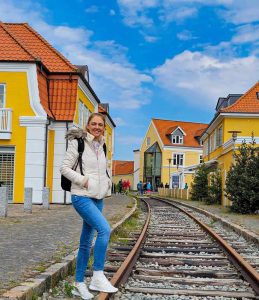 For most of us when we’re looking at booking a cruise, we focus on the incredible ports we’re going to visit. You know that as well as huge cities such as Barcelona and Rome, you’re also going to get smaller ports thrown in. But what you may not realise is that sometimes these small ports can be equally enjoyable.
For most of us when we’re looking at booking a cruise, we focus on the incredible ports we’re going to visit. You know that as well as huge cities such as Barcelona and Rome, you’re also going to get smaller ports thrown in. But what you may not realise is that sometimes these small ports can be equally enjoyable.
Over the last few years, we’ve began racking up our nautical miles, and our love for cruising has grown immensely. During 2023 we found ourselves booking our first cruise with P&O on the Britannia and it was during this trip we found ourselves in the small town of Skagen which is in Denmark.
If you’ve booked a cruise on the Britannia then check out our guide which includes deck plans, entertainment, and cruising tips.
Of course, Skagen wasn’t high up on our bucket list, but sometimes these great little locations never are. We found our visit there memorable and hopefully we can help you plan so that your time in this fishing port is enjoyable.
Ad Disclaimer!
This website uses paid adverts and affiliate links, these come at no additional cost to you and help us to fund the operation of the website, meaning we can continue to provide you with valuable content.
The money received from these links and adverts do not influence any recommondations made within our content.
A Little About Skagen
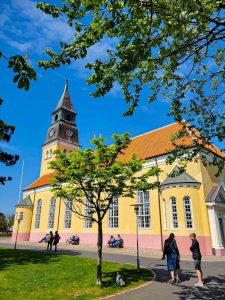 You may be wondering why this little town is such a popular destination for many cruise lines heading towards the Baltic Sea. Skagen is ideally located because it can be found on the northernmost tip of Denmark, which is the entrance way to the Baltic area. It is on the east coast of the Skagen Odde peninsula, which is in the far north of Jutland, part of the Frederikshavn Municipality in Nordjylland.
You may be wondering why this little town is such a popular destination for many cruise lines heading towards the Baltic Sea. Skagen is ideally located because it can be found on the northernmost tip of Denmark, which is the entrance way to the Baltic area. It is on the east coast of the Skagen Odde peninsula, which is in the far north of Jutland, part of the Frederikshavn Municipality in Nordjylland.
Skagen is a well-known fishing port in Denmark, which has been a haven for fishermen since the 12th century. But due to its location it has become increasingly popular as a tourist destination, more specifically for cruise ships. In fact, they attract over 2 million visitors to this small town annually, which when you walk around this quaint area you can easily understand why.
There has been a huge Skagen art scene since the 1800’s, so it’s the ideal place to pick up a masterpiece as you travel. It was so popular that Danish royalty established a summer residence there in 1914, and it remains a popular resort in the warmer months for Danes.
What really stands out when you visit Skagen are the uniquely idyllic houses and buildings which are all uniform in colour. Within the town there are architectural rules where all houses maintain a shade of yellow and have red tiled roofs.
Cruise Port Skagen
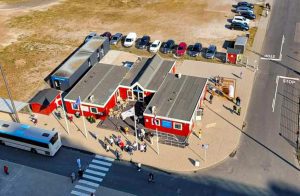 At the time we visited Skagen, one of us had an injury, so we never even considered walking into the town. We immediately headed towards the shuttle bus transport which was offered through P&O Britannia who we were cruising with, and paid four pounds per person each way.
At the time we visited Skagen, one of us had an injury, so we never even considered walking into the town. We immediately headed towards the shuttle bus transport which was offered through P&O Britannia who we were cruising with, and paid four pounds per person each way.
Had we been fully mobile and healthy then without doubt we would have walked into Skagen. The port itself isn’t much to look at because it’s pretty much a busy fishing area; so, expect strong odours. You will find a red wooden building which offers welcome facilities including information about the town, a lounge area, restrooms, the atypical souvenir shop and free WIFI.
Every time we arrive at a new port, we love to head straight up to the top deck to get that first view of the area. Most of the time it’s a working dock like Skagen which is nothing to look at, but sometimes you get that awe inspiring back drop. Some memorable ports are Skjolden in Norway and Kotor in Montenegro.
If you’re heading to either of these ports, then please check out our guides to Skjolden and Kotor.
Exiting the port is the same as many others you will visit, where you walk through a gated security area. From there you have a 5-minute shuttle bus ride or 20-minute walk. It’s relatively easy to make your way to the center by foot because it’s well signposted and flat, with no hills.
When to Visit Skagen
When you visit will generally be influenced by your cruise, but it’s good to know what the temperature and weather will be to help with your packing. Like most parts of Europe, the weather in Skagen can be quite changeable through the day and what can start off as rainy, quickly becomes sunny.
If you’re looking for further advice on ‘What to Pack for a Cruise’, then check out our guide.
The best time to visit Skagen is the summer, more specifically June to August, because it’s milder. But that shouldn’t put you off heading here in the Spring and Autumn months. We went in May and although we needed jackets, it was still quite mild weather.
Because of its latitude you’ll find that during the summer months, even after the sun sets it doesn’t get completely dark; this is known as white nights. We have experienced this before on cruises to Norway and it’s definitely one for the bucket list.
Winter tends to be cold and rainy, but it’s rare to find many cruise itineraries heading that way at that time of year.
Attractions in Skagen
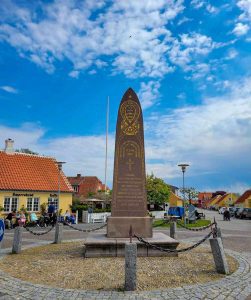 Although this is a small town, there is still plenty to do there during your cruise pit stop. Not only will you meet the friendliest people, but there are historic sights, museums, art galleries, shops, and restaurants. Remember that Skagen attracts artists, so this is the ideal place to peruse for new artwork, as well as smaller crafts. We saw some incredible pieces in a number of galleries, but sadly we arrived at Skagen on a Sunday, and they were all closed.
Although this is a small town, there is still plenty to do there during your cruise pit stop. Not only will you meet the friendliest people, but there are historic sights, museums, art galleries, shops, and restaurants. Remember that Skagen attracts artists, so this is the ideal place to peruse for new artwork, as well as smaller crafts. We saw some incredible pieces in a number of galleries, but sadly we arrived at Skagen on a Sunday, and they were all closed.
But if that doesn’t sound like your thing, then you can simply wander around and take in the unique architecture.
So here is our list of attractions in and around Skagen, which should make planning your own visit a little easier.
Walk Around Skagen Town Centre
One of the best things to do in Skagen is wander around the town and enjoy the shops, cafes, and restaurants. The town is quite compact and easy to walk around and there are so many quaint shops that you could easily spend a couple of hours meandering about. But we also loved checking out the architecture of the town, with the beautiful, yellow-coloured houses which were everywhere. There’s also a scenic harbour front with restaurants and bars which is ideal when the sun is shining.
Grenen – The Meeting of Two Seas
Because of where Skagen is positioned, you have the opportunity to witness and dip your toes into two seas. Grenen is a popular spot for visitors and for good reason, because the narrow spit of land, marks the separation between the North Sea and the Baltic Sea. The Danish straits which connect both seas are called Skagerrak and Kattegat, and by standing in two seas you’re definitely enjoying a bucket list experience.
Grenen is about 5km from Skagen, which is 7 minutes by car or 45 minutes if you fancy the walk. There are taxi’s around but bear in mind this is a small town so the number will be limited. Other popular options to make the journey easier are bicycle or grabbing the city bus.
You will find a bike rental place next door to the Vinoble Wine shop and across the road is the pickup and drop off spot for the Grenen bus. The bus will take you to the Bunker Museum and there you will grab the tractor bus known as the Sandormen, to where the seas meet. Just make sure you have money with you, because most transport there is cash only and you have to pay the driver.
Because Skagen is quite small, it would make sense to head out to the more distant attractions first and then work your way back. If you decide to walk, then make sure you grab a map from the visitor’s centre in the port.
Råbjerg Mile Dunes
This natural attraction is probably best seen via an excursion because of the location and need for transport. You can take a taxi for the 20-minute drive to Råbjerg Mile, other than that there is no direct connection.
So, what exactly is Råbjerg Mile? Found on the Jutland Peninsula it is the largest moving sand dune in Northern Europe and because of its vast size it is a spectacular sight. In the 16th and 17th centuries these shifting dunes were a big problem as they would move inland, some as much as 4 miles. This led to the government working to alleviate the problem in the 19th century, by planting dune grasses and conifers to stabilise the sands.
Even with the addition of plants, the dunes, and the 3.5 million m³ of sand move an average of 15 meters northeast per year. It’s expected that in around 100 years the Råbjerg Mile will cover the main road to Skagen, which shows the ever-changing impact nature can have on our lives.
Be prepared for a workout as you climb the many sandy hilltops and take in the beautiful sight of the dunes and the west coast of Skagen. Some of the dunes are as high as 40 metres and the fine sand can make it a difficult walk.
For most people the desire to see Råbjerg Mile is because of its immense size, where you can almost feel as though you’re in a desert. This is nature at its finest, but just be careful of the wind because it can impact your experience at the dunes, so preparation is key, i.e. a scarf to protect your face.
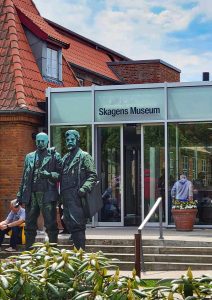 Skagens Museum
Skagens Museum
Found not far from the central hub of the town is the Skagens Museum which is an art museum. It displays an extensive collection of artworks from Skagen painters who lived and worked in the area during the late 19th and early 20th centuries.
This includes artists such as P.S. Krøyer, Anna and Michael Ancher, Viggo Johansen and Holger Drachmann. At the front of the museum is a statue of Michael Ancher and P.S. Krøyer which was installed the year the museum opened.
Many of these Scandinavian artists who emulated French impressionism, painted local sights such as fishermen, beach landscapes, seascapes, and the local community. You’ll also find special exhibitions such as childhood drawings from the artists or their sketches and studies.
The museum opening times are dependent on the season, but it’s mainly 10am to 4 or 5 pm. There’s even a café which is the perfect place to take a moment and relax with a drink.
Anchers Hus
As two of the most celebrated painters in Scandinavian art, it would make sense that Anna and Michael Ancher’s work would be displayed in the Skagens Museum. Because they were so important, their home and studio have been preserved and thankfully we have the opportunity to visit.
Anchers Hus is a 3-minute walk from the Skagens Museum, and you can buy a combination ticket which includes both of these and the Drachmanns Hus. Both the Anchers and their daughter Helga Ancher moved into the beautiful red house on Markvej 2 in the spring of 1884. The house has been preserved as it was when Anna Ancher died in 1935 and is home to a large collection of over 250 works of art by other European artists.
Alike the Skagens Museum, the hours you can visit Anchers Hus are seasonal but for most of the year it’s between 10am and 4pm.
Drachmanns Hus
Alike Anchers Hus, Drachmanns Hus was home to the popular author and painter Holger Drachmann. He was one of the most talked about figures in Scandinavia in the last quarter of the 19th century and one of the first artists to arrive in Skagen. The museum has kept his cottage to look as it did when he lived there between 1902 and 1908. It has about 150 of his works on display including drawings and paintings.
Visiting hours again are seasonal but for most of the year it’s between 11am and 4pm.
The Sand-Covered Church
The Sand-Covered Church is about a 40-minute walk from Skagen town centre and is on the way to the Råbjerg Mile; although we wouldn’t recommend walking to that as it is a fair distance. We have seen a few comments that the church isn’t worth visiting, but if you’re heading that way it would make sense to see this former Saint Lawrence of Rome Church which dates back to 1355 AD.
What makes this a popular tourist spot is the fact that during the latter part of the 18th century, the church was partially buried by sand from the nearby moving sand dunes. Because of this the congregation would have to dig out the entrance whenever there was a service. This endless struggle led to the church being abandoned in 1795, and it was demolished with exception of the crow-stepped gable tower. The site has never been excavated but it is believed that the floor, altar, and baptismal font are under the sand.
Visiting the remains of the church is completely free and you can take a narrow spiral staircase up two levels in the tower. What we love about this attraction is the combination of the impact of nature, alongside history. It’s also the perfect place to head if you love a good walk with beautiful sights.
Skagen Graa Fyr (Skagen Lighthouse or Grey Lighthouse)
Skagens first lighthouse is called the White Lighthouse and if you want to visit this site then you’re looking at a 45-minute walk. If you fancy something closer which is 35 minutes away, then you can see the Skagen Lighthouse, also known as the Grey Lighthouse.
The Skagen Lighthouse is a round brick tower with a lantern and gallery, and it reaches a height of 46 meters or 151 feet. It currently has a two-tonne rotating lens resting on mercury and 400-watt sodium lamp. But originally there was a five wicked paraffin lamp, which was then replaced by an electric lamp.
Although it is still an active lighthouse, it is also a working bird observatory and as such is ideal for the enthusiasts out there. The lighthouse began operation in 1858 and until 1952 it was the country’s tallest. Since 2017 there has been an interactive exhibition on migrating birds which you can visit.
If you fancy visiting the lighthouse then it is open seasonally with hours depending on the time of year (tends to be between 10am and 4 or 5pm). The bird museum is within the lighthouse and there are 208 steps to the top where you can enjoy stunning views.
The Bunker Museum
Found at the tip of Grenen, the museum is an old German bunker of the Regelbau 638 type which was used during the Second World War as part of their Atlantic wall. This specific bunker was an infirmary for treating wounded German soldiers.
The museum is close to the Sandormen (Sand Worm) transport and although it’s small there’s still a number of interesting artifacts and exhibitions including weapons, uniforms, a film room and operations room.
As with the other attractions the Bunker Museum is seasonal and tends to be open between 10am and 5pm.
Brøndums Hotel
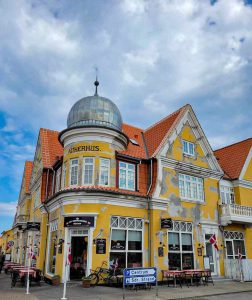 If you take the shuttle bus from the port, then this is probably one of the first buildings you’ll see. Although it’s an active hotel and restaurant, the Brøndums Hotel holds a lot of history in Skagen. The dining room was the place for gatherings of artists in the town, and they installed panels of inset paintings along the walls of the room which were later moved to the Skagens Museum. Michael Ancher arrived in Skagen in 1874 where he struck up a close relationship with the Brøndoms, marrying their daughter Anna in 1880. He then encouraged more artists such as Viggo Johansen to join them.
If you take the shuttle bus from the port, then this is probably one of the first buildings you’ll see. Although it’s an active hotel and restaurant, the Brøndums Hotel holds a lot of history in Skagen. The dining room was the place for gatherings of artists in the town, and they installed panels of inset paintings along the walls of the room which were later moved to the Skagens Museum. Michael Ancher arrived in Skagen in 1874 where he struck up a close relationship with the Brøndoms, marrying their daughter Anna in 1880. He then encouraged more artists such as Viggo Johansen to join them.
Notable guests at the hotel were Hans Christian Andersen and Karen Blixen who wrote Out of Africa.
Skagen Kirke – Skagen Church
Close to the main shopping street of Skagen town centre, you’ll find the church which was built in 1841. The inside is beautiful and incredibly white, with boats hanging from the ceiling and white roses on the pews. You can access the church between 10am and 6pm but be mindful that this is an active church and consider the feelings of local parishioners.
Skagen Water Tower
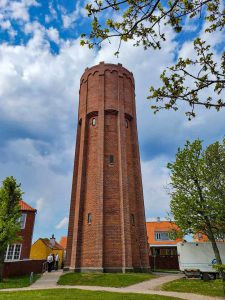 If you visit the Skagens Museum, then you’ll spot the water tower which was built in 1934. It was built using 130,000 red bricks, is 34 meters high and could contain 150,000 litres of water. Although it’s no longer operational, you can climb up the 120 steps to the top and enjoy the views of beautiful Skagen.
If you visit the Skagens Museum, then you’ll spot the water tower which was built in 1934. It was built using 130,000 red bricks, is 34 meters high and could contain 150,000 litres of water. Although it’s no longer operational, you can climb up the 120 steps to the top and enjoy the views of beautiful Skagen.
Mindestotten Memorial
Close to the water tower is a stone memorial which honours eight fishermen who lost their lives on December 27, 1862, during a rescue action for the Swedish ship “Daphne.”
Skagens Bamsemusem
What can only be described as a quaint teddy bear museum, the Skagens Bamsemusem is ideal for the families out there. In there you’ll find bears from various countries and eras, with displays offering the historic background.
Kystmuseet
This small museum is home to a permanent exhibition of what life in Skagen was like through the years, but more specifically the 19th century. You’ll discover a lot about the impact of the fishing industry, with artifacts and informational displays, although most of them are in Danish.
When you’re looking up cruise itineraries, Skagen probably isn’t a place which you’d consider as a must visit. We saw it as an addition to our Baltic cruise and didn’t really plan to do much other than wander. But we were wrong, because we view Skagen as one of the better stops on that entire cruise.
As well as being a really pretty town, Skagen is very easy to navigate and because the terrain is quite flat, you’ll find walking around is easy.
As a cruise stop it is ideal because most attractions are in the town centre and as such are walkable, especially if you opt for the shuttle bus from the port. There are a couple which are further away such as Grenen, Råbjerg Mile and the Sand-Covered Church, so if you’re not up to the walk then you’ll need to use some form of public transport or even hire a bike.
But to make the most of your time in Skagen it isn’t necessary to walk long distances, you can simply focus on the town itself, the culture, food, and the impressive collection of museums.
Make sure you tag us on Instagram if you end up visiting magnificent Skagen, we love to see what you’re up to as you tick off your bucket lists.